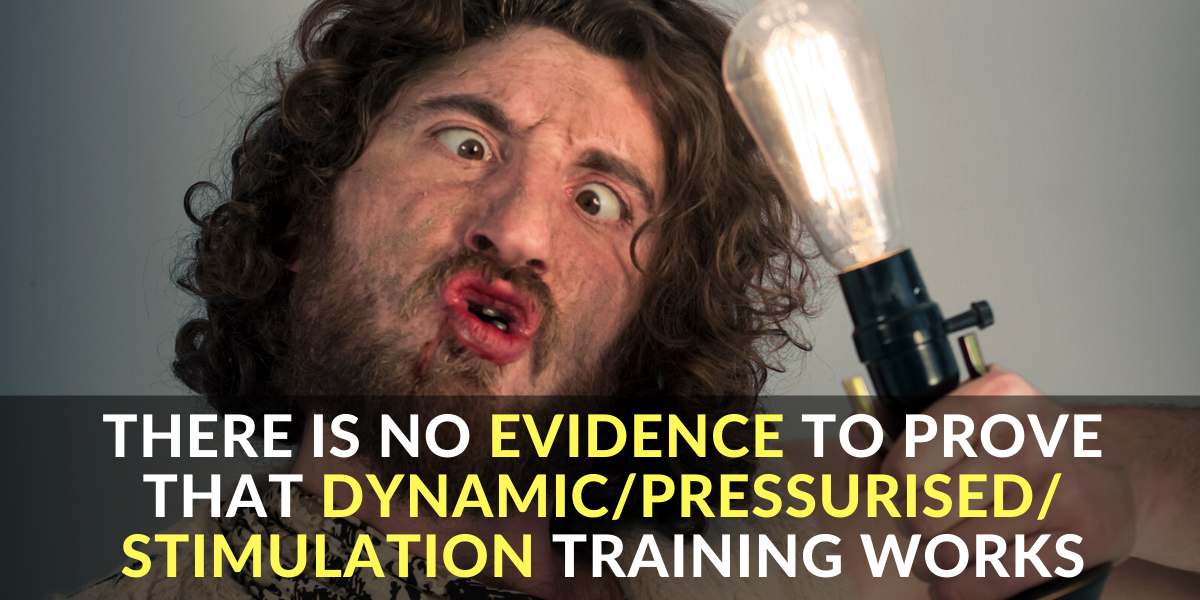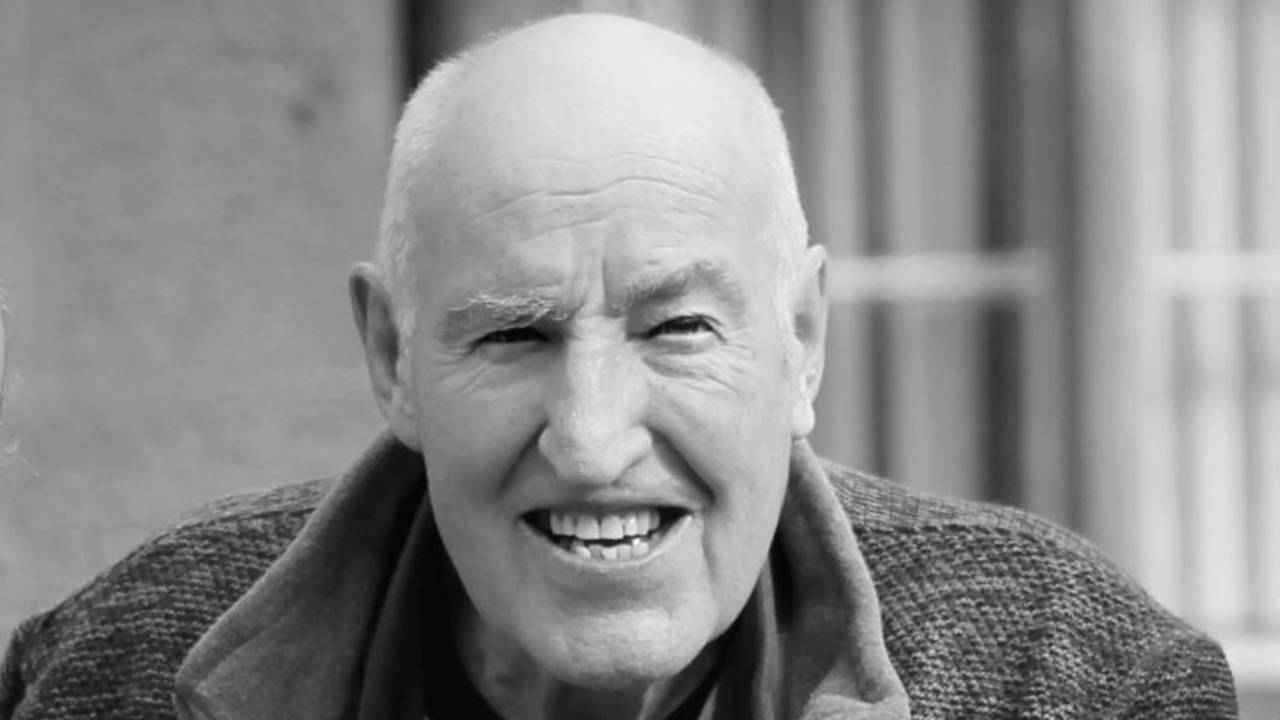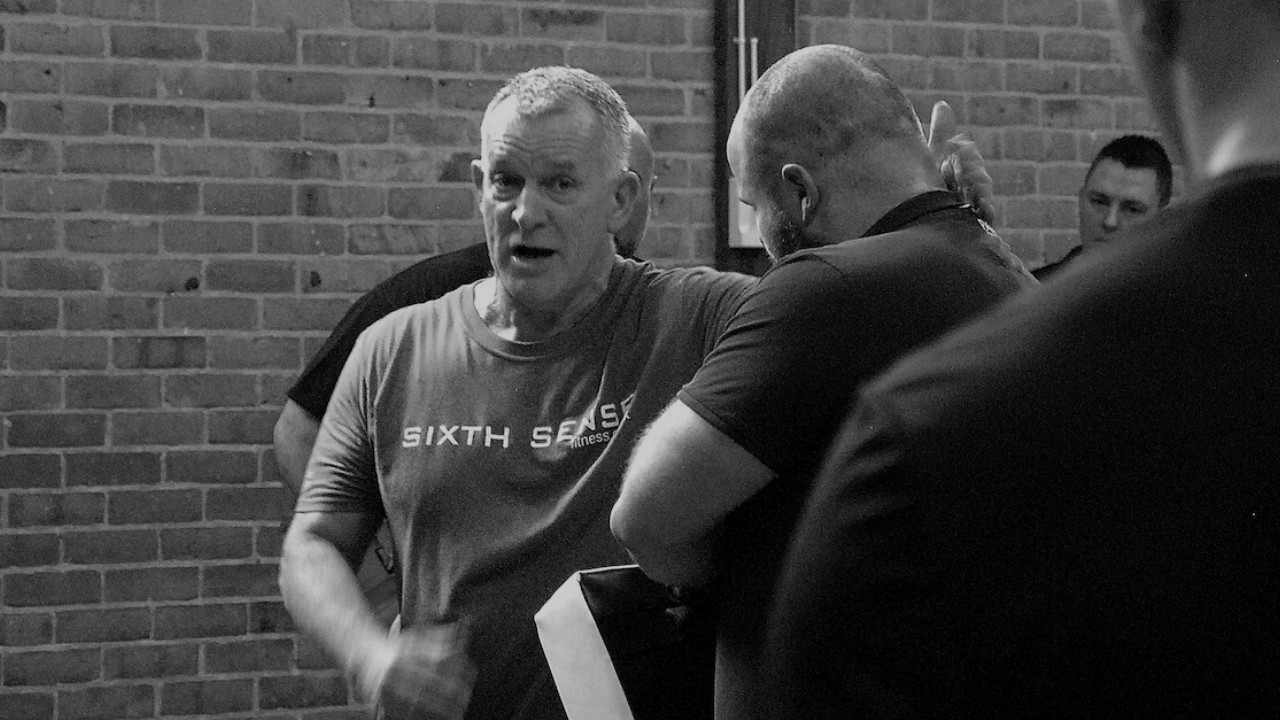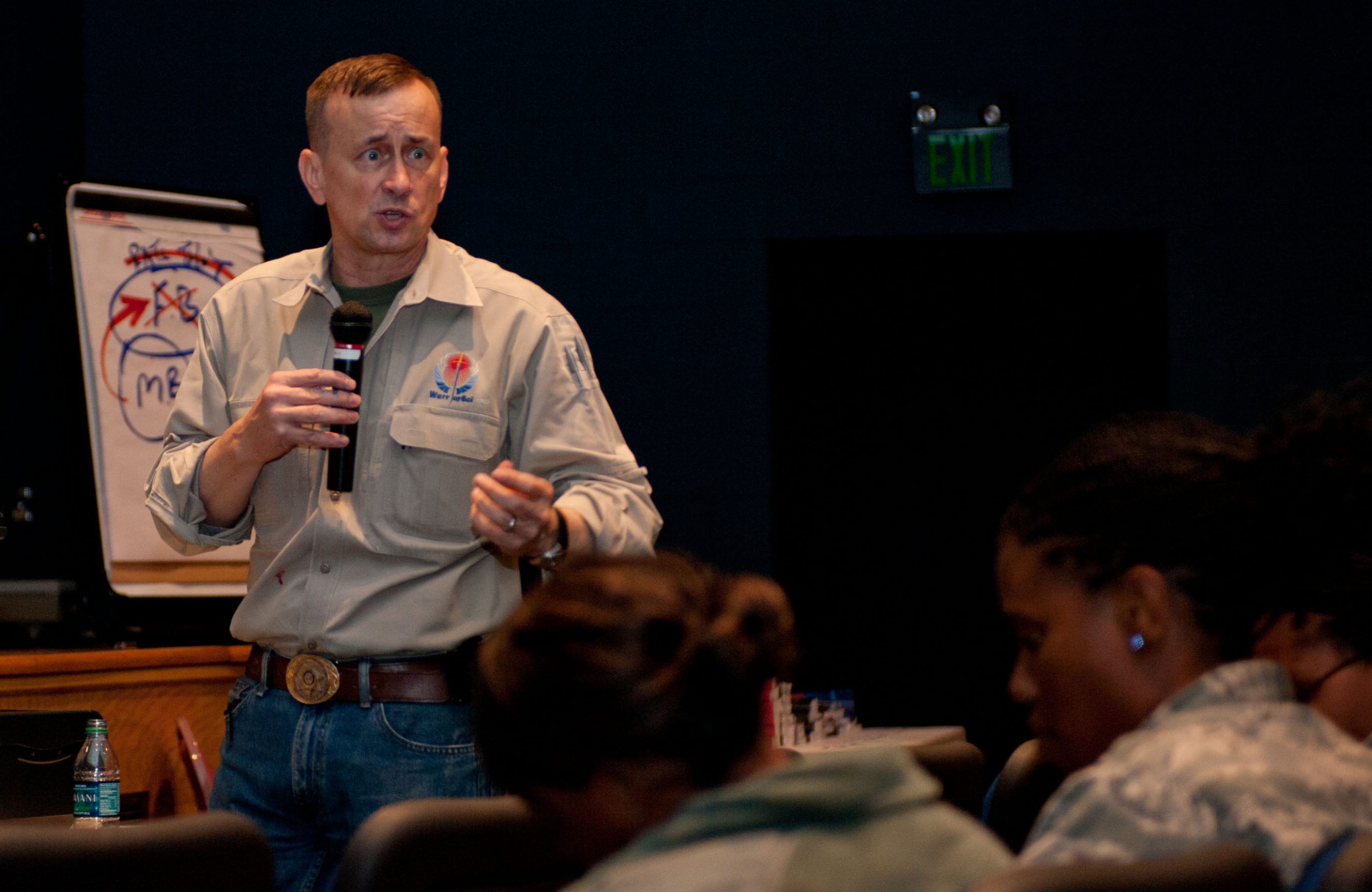The title of this blog post is based on something someone recently said to me, and the person who said it told me that they were quoting something said to them by someone else.
Apparently, according to the person I spoke to what was exactly said to them was:
“There is no research evidence that proves that pressurised/stimulation/dynamic training works”, but there is evidence to show that “it has been associated with a high risk of injuries”.
Apparently, the aim of this statement is to discourage organisations from having staff undertake any pressurised role-play scenarios during physical restraint (also known as physical intervention/pmva/control and restraint, etc.) training to avoid any risk of injury.
The Risk of Injury
There will always be a risk of injury when delivering physical restraint training, especially when running any dynamic/pressurised role-play scenario, and there is a duty under the Health & Safety At Work Act 1974, to ensure that any activity is run safely and in line with an assessment of risk (required for all hazardous activities).
If this is done properly, then the risk can be minimised, and this is something that we have been doing successfully for many years.
The other thing that trainers have to consider is the fitness level of staff. For example, many staff now carry injuries that could be exacerbated (made worse) by the activity.
There is also the duration of the training course to consider.
For example, new staff who are being trained to physically control someone exhibiting high-levels of violence and aggression who are unfamiliar with their new working environment will be naturally nervous.
So expecting them to be proficient in restraint by re-creating the reality of the type of high-level situations that staff are likely to encounter in a relatively short training session is possibly unrealistic.
However, if the exercise is set to an achievable level, and staff are assessed for their capability and proper supervision is in place, a dynamic/pressurised role-play scenario is an excellent learning tool to help staff experience using the techniques they have been taught in a dynamic manner.
This can help increase staff confidence.
There Is No Evidence That Proves That Pressurised/Stimulation/Dynamic Training Works
Now let’s explore the statement further – “There is no research evidence that proves that pressurised/stimulation/dynamic training works”.
As many of you may know I served in the Royal Navy and ended my career as a Royal Navy Officer. During that time I underwent aircrew dunker training.
The aim of the ‘dunker’ is to teach aircrew how to exit a helicopter if it ditches at sea.
A video of that type of training can be seen below.
I also undertook ship damage control training and fire-fighting training, and again, here is a video that shows the type of training I undertook.
I have also undergone military training and survival training, the essence of which was to enable myself and others to experience the pressures and stresses of near-real situations that we may encounter and to inoculate us against those stressors.
We even had to do these exercises is the dark to simulate working at night or in a power-failure/blackout.
And guess what – it worked and no-one was seriously injured and died!
The fact is, if a helicopter ditches in the sea, or if a ship gets damaged or part of it catches fire at sea no-one else is coming.
We have to deal with that and I can’t imagine how we would have done any of that effectively without the benefit of any pressurised/stimulation/dynamic role-play training.
John ‘Lofty’ Wisemans Opinion
I also took the liberty of emailing my good friend John ‘Lofty’ Wiseman on this, and if you are one of the rare people who has never heard of Lofty, below is a resume of his time in the SAS.
John ‘Lofty’ Wiseman applied for service with the Special Air Service Regiment in 1959 and set a record as the youngest person ever to pass selection at the age of 18.
He served with 22 SAS for 26 years (and, as he likes to point out, 55 days)!
He saw active service worldwide, in every theatre of operations and special operations required of the British Army between 1959 and 1985.
Amongst other things, John was:
- Sergeant Major, B Squadron (Sabre Sqn)
- 22 SAS Sergeant Major
- 22 SAS Training Wing Head of Operational Research
- 22 SAS Set up the SP Team (Counter Hi-Jack) Set up the SAS Counter-Terrorist Team (you know…those chaps who ended the Iranian Embassy siege)
- Trained the first members of the US Green Berets to return to the USA to form the famous Delta Force (US Special Forces).
- Lofty also ran the famous SAS Selection Course, deciding who was fit to join the Regiment.
By the time he retired from active service in 1985, he was held in such high esteem that it could be said of him, to directly quote the Commanding Officer of 22 SAS at the time, “Lofty is a legend in this Regiment”.
The reply I got from Lofty is as follows:
“Hi Mark, the old adage train hard fight easy is so true. The training must always be harder than the actual operation. You must experience the worst possible scenario to be able to deal with it. In a real-life situation, unless you have experienced it or trained for it, only disaster will result.”
Lofty Wiseman Ex-SAS
Richard ‘Ginge’ Johnson’s Opinion
I also took the liberty of emailing Richard ‘Ginge’ Johnson, and if you don’t know who Ginge is here’s a bit about him.
- ‘Ginge’ served in the British Army for 18 years, 13 of which were spent in the 22nd Special Air Services Regiment.
- During this time, he developed a wide range of skills including counter-terrorism and VIP protection.
- Ginge joined the private sector in 1990 and has worked for a number of private security companies operating as an international security consultant.
- He has experience working for Government officials, multi-national companies and senior executives and has become recognised as one of the leading experts in the field of VIP protection and business security.
- Over the years Ginge has been responsible for the training of various close protection teams and operated exclusively as a security coordinator within high and low-level personal protection.
- During the past 10 years, Ginge has been involved in designing and delivering security awareness and personal safety/conflict management training for high network corporations families living or travelling to high-risk regions worldwide.
- Currently, Ginge has been asked to be part of a Close Protection Expert Group with the Security Industry Authority to review the current National Occupational Standards with the SIA in relation to Conflict Management and Situational Awareness within Close Protection, to bring it more up to date with the needs of current close protection operatives.
This and the reply I got from Ginge:
“Reference the email and the academics statement which I personally like yourself disagree with… your explanation is very much how I have found it essential throughout my career worldwide in the process of learning/ confirming understanding and perfecting the individual and team skills in the preparation assisting the outcome to be a success and positive result. Plan -prepare- practice- prevent”
Richard ‘Ginge’ Johnson – Ex-SAS.
Lt.Col. Dave Grossman’s Research
Lt. Col. Dave Grossman talks about this subject extensively in his book “On Combat”.
He quotes a Military Sergeant who told his soldiers,
“You will never rise to the occasion in battle. You will ALWAYS sink to your level of training.”
Lt. Col. Grossman explains that when your heart rate reaches a certain number of beats per minute (bpm), you begin to lose your fine motor skills.
This process starts at 115 bpm and there is a marked deterioration beyond 145 bpm and a catastrophic breakdown of physical and mental performance above 175 bpm.
Your brain’s frontal lobe (the thinking part of your brain) effectively switches off and it’s the training or muscle memory that you’ve instilled in your mid-brain (limbic system) that will either save you or potentially hurt you.
Now for some staff (and I don’t mean this is a detrimental way), they may not be in the best physical condition.
They may be carrying injuries and have health conditions. Some may even have a resting heart rate of 145 bpm upwards and could easily reach 175 bpm from simply walking up a flight of stairs.
Therefore, we have to be mindful that skill breakdown is likely to occur relatively easily and that is why any physical skills taught should be simple.
They should comprise the least number of movements and allow staff to control someone quickly and effectively.
I recently produced a podcast on this which you can listen to below.
There Is A Real Need For Stress Inoculation Training
Being able to perform in stressful situations at work or in any potentially dangerous situation, requires training, and part of that training must be stimulating and should mimic the stressful situation to be encountered (within the parameters of safety and within the capability of the staff and the duration of time that you have them for).
A point to note is the more you are exposed to any stressful situation, the more you become accustomed to it and learn to actually think through it.
A Flawed (Possibly Self-Serving) Hypothesis
It is relatively easy for an academic to create a hypothesis (a supposition or proposed explanation made on the basis of limited evidence) that there is no research evidence that proves that pressurised/stimulation/dynamic training works if they are only looking at it from a biased perspective and searching for examples (injuries in this case) to support that particular bias.
Or maybe this is from a self-serving perspective to promote the fact that their particular organisation have never had an injury during training on the basis that they don’t do any pressurised/dynamic/scenario training?
Maybe I’m just a simple bloke, but to me that’s like saying I have never cracked an egg when cooking a meal, but intentionally omit to say that I don’t eat eggs!
A Negligent Omission
On a serious note, I think that the omission of any pressurised/dynamic/scenario training in a physical restraint training programme is a negligent omission because if staff cannot be given the opportunity to practice what they need to use operationally then the training provider is failing the people they are training and creating a liability for the organisation that has commissioned them to train their staff.
The question that we should be asking is ‘what happens if we don’t train people properly and innocculate them for the stressors they are foreseeably likely to encounter?
Answer: The organisation is negligent and becomes liable under a breach of various Acts of Parliament, including the Health & Safety at Work Act.
And if someone dies the organisation could face charges of Corporate Manslaughter.
The Solution
Pressurised training, if done properly, to the right level and with the proper controls in place is a very important aspect of training that should not be omitted.
This is something we teach trainers to do on our BTEC Level 3 Restraint Instructor Award Course for nearly thirty years now, and guess what – we’ve never had any major injuries.
To learn how to run pressurised/dynamic training scenarios safely join us on our next BTEC Level 3 Restraint Instructor Award Course – https://nfps.info/physical-intervention-trainer-course/
I’d be interested in your comments.
Best Regards
Mark Dawes





Yes, great article and very true. It’s the difficult position. A significant number of people have no sense of the reality of what awaits in a SD scenario and potentially little motivation to engage with that reality. In terms of delivering to organisations, few trainers will want to lose a contract by stressing to the client the importance of stress/pressure training but most acknowledge that without it, you are at best preparing people for low level de-escalation and nothing more.
The times I have tried this it has been a very valuable reality check for me! We need to know when we are being unrealistic in what we do, as it might get us into serious trouble if we are overconfident .
I have this quote on my office wall which sums this up:
“”To plan manoeuvres so that some of the elements of frication are involved…is far more worthwhile than inexperienced people might think. It is immensely important that no solider…should wait for war to expose him to those aspects of active service that amaze and confuse him when he first comes across them. If he has met them even once before, they will begin to be familiar to him. – General Carl von Clausewitz, Vom Kriege (On War).
Stress inoculation and repetition under stress is vitally important in many areas. I am now based in a health simulation department in a large hospital and we have nurses, surgeons etc working in the mock wards and theatres on dummies carrying out procedures under stress. It is amazing to watch. I know personally I would like to be operated on by someone who has some experience with a scalpel.
Hi Mark, great article,
I would rephrase that in the following sentence:” There is No Evidence To Prove That An Academic know what they are talking about outside Their Theoretical Buble”
I like this better Plan -prepare- practice- prevent
Cheers
Aziz
Hi Aziz,
Excellent. Thanks for commenting!
Best Regards
Mark
Very interesting Mark and I have to say based upon personal experience very wrong. It would be very interesting to know what the academic bases his / her hypothesis on,
Being Ex Mil as you know, I was heavily involved in field firing training where at the School of Infantry the saying was “as close to the line as you possibly can without crossing it” yes injuries occur but as you quite rightly say if the activity is correctly risk assessed then pressurised training is the most valuable tool there is.
Taking away self defence and PI as examples where pressurised training is used, what about sportsmen? Track cyclists, rowers, weightlifters will train far harder than any of their event would warrant in terms of energy expenditure etc.
The legend that is Lofty Wiseman hits the nail in the head. “Train hard fight easy”
Hi Sandy
Thanks for your input on the post my friend.
Hope all is well with you.
Speak soon.
Mark
Hi Mark,
Great blog as always.
I concur with your view on this and also believe that the academic who has proposed this has undertaken some seriously flawed research.
For me, the comments of Lofty and Ginge say it all. I always point out to people how the brain and body works under stress and that you will resort to the base level of training, or instinct in a high stress situation.
Also from a legal perspective you are correct in you comments as to Health and Safety at Work Act and also in the event of a death The Corporate Manslaughter and Corporate Homicide Act 2007 would definitely kick in.
Kind regards,
Tony Power LLB (Hons)
Hi Tony
Thank you for your comment and for corroborating my view on this.
Speak soon.
Mark